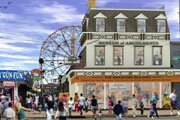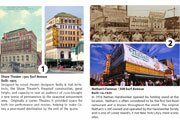Bank of Coney Island
The Bank of Coney Island building was built c. 1923 on West 12th Street, just south of Surf Avenue. The bank was design by Holmes & Winslow, architects that specialized in bank design. Holmes & Winslow were responsible for the design of numerous banks in the New York and New Jersey area, including the East New York Savings Bank (1929); the Metropolitan Trust Company, 5th Avenue branch (c. 1916); the Newton Trust Company in Newton, NJ (1923-25); and the main office of the Independence Savings Bank at 130 Court Street in the Cobble Hill Historic District (1936, Charles A. Holmes only). Their design for the Bank of Coney Island is executed in stone and includes traditional classical motifs, such as double height arched entrance flanked by Doric pilasters and capped by a keystone; keystones above the two-ached windows; a dentiled cornice below the attic level; and a stone string course above the attic floor windows. The ironwork at the arched windows is likely original.
The existing building was originally part of a larger bank complex that extended to the corner of Surf Avenue. The extant portion of the building appears to have been the main banking hall and public area, as evidenced in recent photos of the interior and the fact that c. 1940s, the corner building housed a typical Coney Island game on its ground floor. Historic photos from the 1950s show that the extant part of the bank building is virtually unchanged from the 1950s, except for the removed (or obscured) windows and doors. Many of the interior details of the banking hall remain as well.
The Bank of Coney Island was originally formed in 1909 by the businessmen of Coney Island in order to provide a banking institution dedicated to serving and the strengthening the businesses and industry of immediate area. According the publication, The Capitalist, the bank had an original capital of $100,000 and planned to raise $50,000 more through the sale of stocks at $150 each. The publication notes that other banks a few miles away in less populated areas had been extremely successful and it was expected that this bank, which was “purely a local concern, and will draw its support entirely from the islanders,” would also be extremely successful.
The Bank’s first president and primary petitioner to New York State for the bank’s formation was Stephen A. Jackman. Jackman, according to the Capitalist, held “large real estate interests in Coney island and surrounding vicinity and is regarded as a man of integrity and business ability.” He was an early developer of roller coasters and amusement rides. According to a 1927 article in the St. Petersburg Times, Jackman worked with his brother, Charles, on many of his ride designs. Jackman’s first roller coaster was built in Haverhill, Massachusetts in 1883. He and his brother arrived in Coney Island in 1890, and over the years, they developed several early Coney Island roller coasters and rides, including the Blue Slide, the Victoria Slide, Jackman’s Thriller, Whirlwind Ride, and Shooting the Rapids.
Among the other early founders of the Bank of Coney Island were other well-known Coney Island land and amusement owners. These included Frederick Henderson of Henderson’s Hall; Charles Feltman of Feltman’s beer garden (where the hotdog was invented); Henry Grashorn of the Grashorn hardware store; and William J. Ward, owner of much of the land along Jones Walk, proprietor of the Ward’s baths and other amusements, and developer of Coney Island’s Half Moon Hotel. Ward eventually became president of the Bank of Coney Island, serving for two decades.
The bank originally operated out of an existing bank building located at Thompson’s Walk (site of today’s West 12th Street) and Surf Avenue and formerly occupied by the Jenkins and Lafayette Trust Company. The Bank of Coney Island was successful within its first decade of operation, and in 1919, its leaders applied to New York State to open a branch office at the northeast corner of Surf Avenue and West Bay 25th Street in Coney Island. In the 1920s, the City of New York began to undertake large-scale public works in Coney Island, including the construction of the Boardwalk and the extension of public streets between Surf Avenue and the beach. Several of Coney Island’s private walks were widened to become public streets. Thompson’s Walk was widened to become West 12th Street in 1923, and it is assumed that the original location of the Bank of Coney Island was demolished in anticipation of the widening. Ads for contractors for the construction of the new bank designed by Holmes & Winslow appear in trade magazines in 1922.
The Bank of Coney Island remained independent until 1927 when it was acquired by the National American Company and then sold to the Brooklyn Trust Company in early 1928. New York Times articles from that time indicate that the bank had about $500,000 in deposits, and that the amount often grew to $750,000 in the summer season. The building remained a bank branch of the Brooklyn Trust Company, as it was seen as successful, particularly in the summer months. In 1950, the bank became part of the Manufacturers Trust Company, which was later renamed the Manufacturers Hanover Trust Company in the 1960s. The Bank of Coney Island building continued to be a branch of the Manufacturers Hanover Trust until about 1990. In the 1990s, the building was used as the International Circus Museum, which exhibited curiosities and occasional live acts and was operated by Bobby Reynolds.
The Bank of Coney Island building represents the solidification of the Coney Island’s business community and the economic and civic institutionalism of the area at the turn of the 20th century. Like the Shore Theater, the Stillwell Avenue Station, the Popper Building, and the now lost Half Moon Hotel, it helped define an era of stabilization and public investment in the neighborhood. The bank was founded by and supported Coney Island’s amusement industry and is an integral part of the area’s history as a self-sustaining amusement community. Although the building is currently vacant, it is intact on the interior and exterior and could be reused as a part of a revitalized Coney Island.



